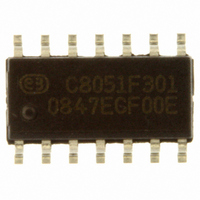C8051F301-GS Silicon Laboratories Inc, C8051F301-GS Datasheet - Page 103

C8051F301-GS
Manufacturer Part Number
C8051F301-GS
Description
IC 8051 MCU 8K FLASH 14-SOIC
Manufacturer
Silicon Laboratories Inc
Series
C8051F30xr
Specifications of C8051F301-GS
Program Memory Type
FLASH
Program Memory Size
8KB (8K x 8)
Package / Case
14-SOIC (3.9mm Width), 14-SOL
Core Processor
8051
Core Size
8-Bit
Speed
25MHz
Connectivity
SMBus (2-Wire/I²C), UART/USART
Peripherals
POR, PWM, WDT
Number Of I /o
8
Ram Size
256 x 8
Voltage - Supply (vcc/vdd)
2.7 V ~ 3.6 V
Oscillator Type
Internal
Operating Temperature
-40°C ~ 85°C
Processor Series
C8051F3x
Core
8051
Data Bus Width
8 bit
Data Ram Size
256 B
Interface Type
I2C/SMBus/UART
Maximum Clock Frequency
25 MHz
Number Of Programmable I/os
8
Number Of Timers
3
Maximum Operating Temperature
+ 85 C
Mounting Style
SMD/SMT
3rd Party Development Tools
PK51, CA51, A51, ULINK2
Development Tools By Supplier
C8051F300DK
Minimum Operating Temperature
- 40 C
Package
14SOIC
Device Core
8051
Family Name
C8051F30x
Maximum Speed
25 MHz
Operating Supply Voltage
3.3 V
Lead Free Status / RoHS Status
Lead free / RoHS Compliant
For Use With
770-1006 - ISP 4PORT FOR SILABS C8051F MCU336-1444 - ADAPTER PROGRAM TOOLSTICK F300336-1319 - REFERENCE DESIGN STEPPER MOTOR
Eeprom Size
-
Data Converters
-
Lead Free Status / Rohs Status
Lead free / RoHS Compliant
Other names
336-1536-5
12. Port Input/Output
Digital and analog resources are available through a byte-wide digital I/O Port, Port0. Each of the Port pins
can be defined as general-purpose I/O (GPIO), analog input, or assigned to one of the internal digital
resources as shown in Figure 12.3. The designer has complete control over which functions are assigned,
limited only by the number of physical I/O pins. This resource assignment flexibility is achieved through the
use of a Priority Crossbar Decoder. Note that the state of a Port I/O pin can always be read in the corre-
sponding Port latch, regardless of the Crossbar settings.
The Crossbar assigns the selected internal digital resources to the I/O pins based on the Priority Decoder
(Figure 12.3 and Figure 12.4). The registers XBR0, XBR1, and XBR2, defined in SFR Definition 12.1, SFR
Definition 12.2, and SFR Definition 12.3 are used to select internal digital functions.
All Port I/Os are 5 V tolerant (refer to Figure 12.2 for the Port cell circuit). The Port I/O cells are configured
as either push-pull or open-drain in the Port0 Output Mode register (P0MDOUT). Complete Electrical
Specifications for Port I/O are given in Table 12.1 on page 110.
Highest
Priority
Lowest
Priority
/WEAK-PULLUP
PUSH-PULL
/PORT-OUTENABLE
PORT-OUTPUT
ANALOG INPUT
PORT-INPUT
Figure 12.1. Port I/O Functional Block Diagram
SYSCLK
Outputs
SMBus
T0, T1
UART
PCA
CP0
Figure 12.2. Port I/O Cell Block Diagram
Port Latch
2
2
2
4
2
P0
Analog Select
(P0.0-P0.7)
8
Rev. 2.9
XBR2 Registers
XBR0, XBR1,
Crossbar
Decoder
Priority
Digital
C8051F300/1/2/3/4/5
8
P0MDIN Registers
GND
VDD
P0MDOUT,
Cells
P0
I/O
VDD
(WEAK)
P0.0
P0.7
PORT
PAD
103










